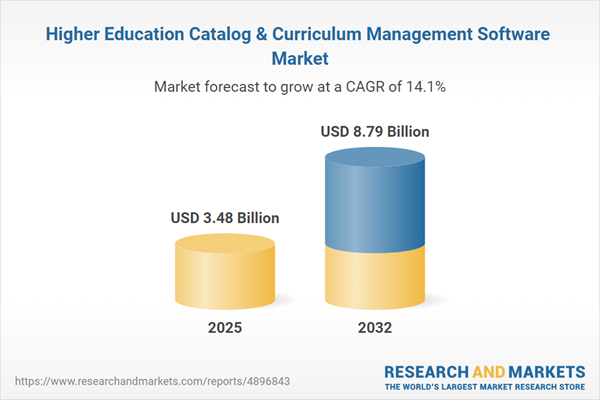Speak directly to the analyst to clarify any post sales queries you may have.
Higher education catalog and curriculum management software is driving administrative efficiency and compliance for academic institutions. As universities respond to digital transformation and evolving governance demands, these solutions provide centralized tools to improve workflows, enhance regulatory tracking, and strengthen multi-departmental collaboration for institutional leaders.
Market Snapshot: Higher Education Catalog and Curriculum Management Software
In 2024, the global market for higher education catalog and curriculum management software reached USD 3.05 billion with expectations of increasing to USD 3.48 billion in 2025 and USD 8.79 billion by 2032. This market is advancing at a 14.13% compound annual growth rate, propelled by active digitalization across the education sector. As universities confront more complex academic structures and stricter compliance standards, technology solutions are gaining traction for modernizing curriculum processes, optimizing resource utilization, and facilitating real-time collaboration among faculty and staff. Regional needs drive adoption across the Americas, Europe, Asia-Pacific, and the Middle East & Africa, each responding to unique regulatory and operational landscapes while seeking enhanced efficiency and agility.
Scope & Segmentation
- Deployment Mode: Cloud-based platforms enable agile and cost-effective implementation, ideal for institutions seeking scalability and flexibility. On-premises systems suit organizations prioritizing data control and established IT security protocols.
- Institution Type: Solutions are tailored to public universities, private colleges, nonprofit entities, and for-profit organizations, each with custom compliance and administrative requirements.
- Organization Size: Platforms support both large research universities and smaller specialized colleges, addressing varying operational capacities and resource needs without restricting scalability.
- Licensing Model: Subscription-based licensing accommodates budget predictability and easy scaling, while perpetual licensing offers a long-term investment approach for institutions with stable funding cycles.
- Component: Modular systems enable academic leaders to configure functionalities such as catalog management, analytics integration for program assessment, and automated accreditation reporting for clear compliance.
- User Type: Administrators, academic leaders, faculty, and students benefit from role-based access, customizable workflows, and improved visibility into curriculum processes and approval cycles.
- Regions: Adoption patterns reflect varied educational standards and regulatory frameworks in North America, Europe, Asia-Pacific, and the Middle East & Africa, shaping localized solution features.
- Leading Companies: Vendors including Ellucian Inc., Oracle Corporation, Workday Inc., and SAP SE are advancing their platforms to address emerging academic and governance needs worldwide.
Key Takeaways for Senior Decision-Makers
- Centralized software platforms deliver process alignment across universities and departments, improving governance and information consistency institution-wide.
- Embedded compliance management tools help academic leaders proactively respond to changing policy requirements, mitigating risk exposure and improving regulatory assurance.
- Cloud-native platforms facilitate timely upgrades and integrate analytics, supporting data-driven decision-making in curriculum design and administrative operations.
- AI-powered mapping and alignment features assist institutions in adapting courses to evolving workforce skills and discipline benchmarks.
- Intuitive interfaces reduce curriculum approval times and promote streamlined collaboration among administrators, faculty, and academic committees.
- Strategic integration of new technologies, coupled with agile planning, leverages institutional resources and prepares organizations for sector changes.
Tariff Impact on Technology Access
Recently enacted U.S. tariff policies have influenced how institutions evaluate and procure digital modernization tools, including both hardware and essential software. In response to these shifting trade dynamics, more universities are considering domestic and open-source solutions to maintain progress despite supply uncertainties. In this climate, vendors have increased support resources in North America, ensuring consistent project delivery and helping academic clients navigate procurement challenges and regulatory transitions.
Methodology & Data Sources
This report synthesizes data from executive interviews, detailed industry surveys, actual software usage statistics, and validated market research. Findings undergo regulatory review and examination of institutional case documentation to ensure accuracy and relevance for higher education technology adoption trends.
Why This Report Matters
- Delivers institutional leaders clear benchmarks for technology risk management and digital compliance in complex academic environments.
- Offers actionable analysis of deployment options and vendor strengths, simplifying decision-making for procurement and strategic transformation.
- Equips planners with expert insights to enhance institutional resilience, enabling proactive resource planning amid evolving academic priorities.
Conclusion
By adopting robust curriculum management software, universities increase administrative efficiency, strengthen compliance, and support organizational adaptability. These solutions provide a foundation for ongoing academic innovation and responsive governance, addressing urgent sector challenges.
Additional Product Information:
- Purchase of this report includes 1 year online access with quarterly updates.
- This report can be updated on request. Please contact our Customer Experience team using the Ask a Question widget on our website.
Table of Contents
3. Executive Summary
4. Market Overview
7. Cumulative Impact of Artificial Intelligence 2025
Companies Mentioned
The companies profiled in this Higher Education Catalog & Curriculum Management Software market report include:- Ellucian Inc.
- Oracle Corporation
- Workday, Inc.
- SAP SE
- Unit4 N.V.
- Anthology Inc.
- Jenzabar, Inc.
- Watermark, Inc.
- CourseLeaf, Inc.
- EAB Global, Inc.
Table Information
| Report Attribute | Details |
|---|---|
| No. of Pages | 189 |
| Published | November 2025 |
| Forecast Period | 2025 - 2032 |
| Estimated Market Value ( USD | $ 3.48 Billion |
| Forecasted Market Value ( USD | $ 8.79 Billion |
| Compound Annual Growth Rate | 14.1% |
| Regions Covered | Global |
| No. of Companies Mentioned | 10 |









